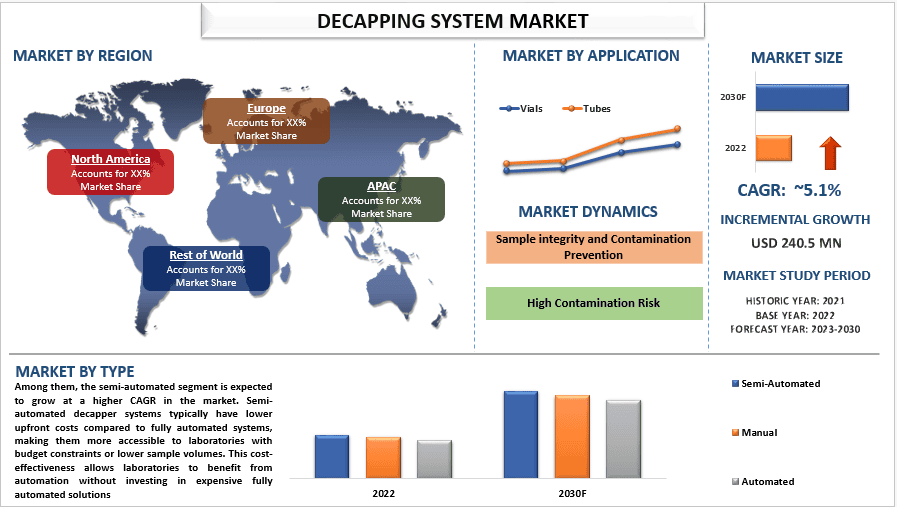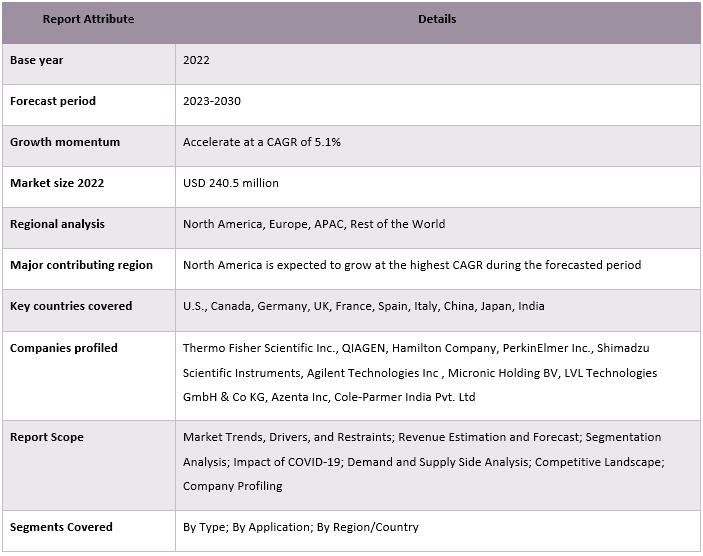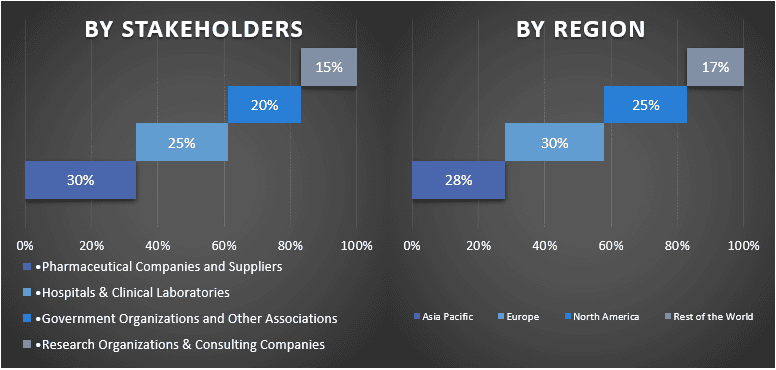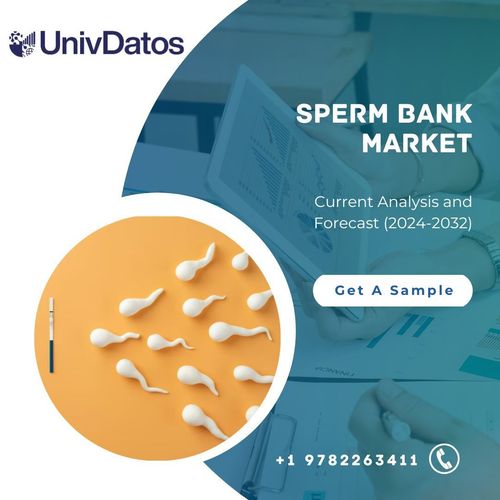Decapping System Market: Current Analysis and Forecast (2023-2030)
Emphasis on Type (Manual, Semi-Automated, Automated); Application (Tubes, Vials); and Region/Country

The Decapping system market was valued at USD 240.5 million in 2022 & is expected to grow at a CAGR of 5.1 % from 2023-2030. The decapping system market refers to the segment of the laboratory equipment market that focuses on automated solutions for removing caps or closures from sample tubes or vials. Decapping systems play a crucial role in sample preparation workflows by automating the labor-intensive process of decapping, thereby improving efficiency, accuracy, and throughput in laboratory operations. The growing trend towards laboratory automation, driven by the need for higher throughput, accuracy, and efficiency in sample processing, fuels the demand for decapping systems. Furthermore, Laboratories, particularly in fields such as genomics, clinical diagnostics, and drug discovery, require high-throughput sample processing solutions to handle large volumes of samples quickly and accurately. Decapping systems offer automated solutions for efficient sample preparation, contribute to the growth of the market. Moreover, Laboratories are under pressure to increase efficiency, reduce errors, and streamline workflows to meet growing demand and optimize resource utilization. Decapping systems contribute to these objectives by automating labor-intensive sample handling tasks.
Some of the major players operating in the market are Thermo Fisher Scientific Inc., QIAGEN, Hamilton Company, PerkinElmer Inc., Shimadzu Scientific Instruments, Agilent Technologies Inc, Micronic Holding BV, LVL Technologies GmbH & Co KG, Azenta Inc, Cole-Parmer India Pvt. Ltd. Several M&As along with partnerships have been undertaken by these players to facilitate customers with hi-tech and innovative products/technologies.
Insights Presented in the Report
“Amongst type, the semi-automated segment held a significant share of the market in 2023.”
Based on the type, the market has been categorized into manual, semi-automated, and automated. Among them, the semi-automated segment is expected to grow at a higher CAGR in the market. Semi-automated decapper systems typically have lower upfront costs compared to fully automated systems, making them more accessible to laboratories with budget constraints or lower sample volumes. This cost-effectiveness allows laboratories to benefit from automation without investing in expensive fully automated solutions. Semi-automated decapper systems offer greater flexibility and customization options compared to fully automated systems. Laboratories can choose which steps to automate and which to perform manually, tailoring the system to their specific workflow requirements and sample types. This flexibility allows for seamless integration into existing laboratory processes and workflows.
“Amongst application, the vials segment held the higher CAGR in the market in 2023.”
Based on the application, the market has been categorized into tubes, vials. Among them, the vials segment is expected to grow at a higher CAGR in the market due to increase demand for vial-based sample storage and processing solutions. Vials are commonly used in laboratory settings for storing and transporting various types of samples, including biological specimens, pharmaceutical compounds, chemicals, and reagents. The increasing adoption of vials as primary sample containers in research, diagnostics, and pharmaceutical industries is contributing to the growth of the vials segment in the decapping system market. Vials are available in standardized sizes, shapes, and materials, making them compatible with a wide range of laboratory equipment and workflows. Laboratories prefer vials for their uniformity and compatibility, allowing for seamless integration into existing sample handling processes and automation platforms.
“North America dominated the decapping system market in 2023.”
The North America Decapping System market is expected to continue to grow in the coming years, driven by the increasing demand for laboratory automation and rising need for high-throughput sample processing. Furthermore, increasing focus on laboratory efficiency and productivity are also likely to aid growth to decapping system market. Moreover, rising investment in life science and in healthcare research are also the main for boosting the growth of the decapping system market.
Decapping system Market Report Coverage

Reasons to buy this report:
- The study includes market sizing and forecasting analysis validated by authenticated key industry experts.
- The report presents a quick review of overall industry performance at one glance.
- The report covers an in-depth analysis of prominent industry peers with a primary focus on key business financials, product portfolios, expansion strategies, and recent developments.
- Detailed examination of drivers, restraints, key trends, and opportunities prevailing in the industry.
- The study comprehensively covers the market across different segments.
- Deep dive regional level analysis of the industry.
Customization Options:
The global Decapping system market can further be customized as per the requirement or any other market segment. Besides this, UMI understands that you may have your own business needs, hence feel free to connect with us to get a report that completely suits your requirements.
Table of Contents
Research Methodology for the Decapping system Market Analysis (2022-2030)
Analyzing the historical market, estimating the current market, and forecasting the future market of the global Decapping system market were the three major steps undertaken to create and analyze the adoption of decapping system in major regions globally. Exhaustive secondary research was conducted to collect the historical market numbers and estimate the current market size. Secondly, to validate these insights, numerous findings and assumptions were taken into consideration. Moreover, exhaustive primary interviews were also conducted, with industry experts across the value chain of the global Decapping system market. Post assumption and validation of market numbers through primary interviews, we employed a top-down/bottom-up approach to forecasting the complete market size. Thereafter, market breakdown and data triangulation methods were adopted to estimate and analyze the market size of segments and sub-segments of the industry pertains to. Detailed methodology is explained below:
Analysis of Historical Market Size
Step 1: In-Depth Study of Secondary Sources:
Detail secondary study was conducted to obtain the historical market size of the Decapping system market through company internal sources such as annual reports & financial statements, performance presentations, press releases, etc., and external sources including journals, news & articles, government publications, competitor publications, sector reports, third-party database, and other credible publications.
Step 2: Market Segmentation:
After obtaining the historical market size of the Decapping system market, we conducted a detailed secondary analysis to gather historical market insights and share for different segments & sub-segments for major regions. Major segments are included in the report as type, and application. Further country-level analyses were conducted to evaluate the overall adoption of testing models in that region.
Step 3: Factor Analysis:
After acquiring the historical market size of different segments and sub-segments, we conducted a detailed factor analysis to estimate the current market size of the Decapping system market. Further, we conducted factor analysis using dependent and independent variables such as type, and application of the Decapping system market. A thorough analysis was conducted for demand and supply-side scenarios considering top partnerships, mergers and acquisitions, business expansion, and product launches in the Decapping system market sector across the globe.
Current Market Size Estimate & Forecast
Current Market Sizing: Based on actionable insights from the above 3 steps, we arrived at the current market size, key players in the global Decapping system market, and market shares of the segments. All the required percentage shares split, and market breakdowns were determined using the above-mentioned secondary approach and were verified through primary interviews.
Estimation & Forecasting: For market estimation and forecast, weights were assigned to different factors including drivers & trends, restraints, and opportunities available for the stakeholders. After analyzing these factors, relevant forecasting techniques i.e., the top-down/bottom-up approach were applied to arrive at the market forecast for 2030 for different segments and sub-segments across the major markets globally. The research methodology adopted to estimate the market size encompasses:
- The industry’s market size, in terms of revenue (USD) and the adoption rate of the Decapping system market across the major markets domestically
- All percentage shares, splits, and breakdowns of market segments and sub-segments
- Key players in the global Decapping system market in terms of products offered. Also, the growth strategies adopted by these players to compete in the fast-growing market
Market Size and Share Validation
Primary Research: In-depth interviews were conducted with the Key Opinion Leaders (KOLs) including Top Level Executives (CXO/VPs, Sales Head, Marketing Head, Operational Head, Regional Head, Country Head, etc.) across major regions. Primary research findings were then summarized, and statistical analysis was performed to prove the stated hypothesis. Inputs from primary research were consolidated with secondary findings, hence turning information into actionable insights.
Split of Primary Participants in Different Regions

Market Engineering
The data triangulation technique was employed to complete the overall market estimation and to arrive at precise statistical numbers for each segment and sub-segment of the global Decapping system market. data was split into several segments & sub-segments post studying various parameters and trends in the areas of the type, and application in the global Decapping system market.
The main objective of the Global Decapping system Market Study
The current & future market trends of the global Decapping system market were pinpointed in the study. Investors can gain strategic insights to base their discretion for investments on the qualitative and quantitative analysis performed in the study. Current and future market trends determined the overall attractiveness of the market at a regional level, providing a platform for the industrial participant to exploit the untapped market to benefit from a first-mover advantage. Other quantitative goals of the studies include:
- Analyze the current and forecast market size of the Decapping system market in terms of value (USD). Also, analyze the current and forecast market size of different segments and sub-segments
- Segments in the study include areas of the type, and application
- Define and analysis of the regulatory framework for the Decapping system industry
- Analyze the value chain involved with the presence of various intermediaries, along with analyzing customer and competitor behaviors of the industry
- Analyze the current and forecast market size of the Decapping system market for the major region
- Major countries of regions studied in the report include Asia Pacific, Europe, North America, and the Rest of the World
- Company profiles of the Decapping system market and the growth strategies adopted by the market players to sustain in the fast-growing market
- Deep dive regional level analysis of the industry
Frequently Asked Questions FAQs
Q1: What is the current market size and growth potential of the global decapping system market?
Q2: What are the driving factors for the growth of the global decapping system market?
Q3: Which segment has the largest share of the global decapping system market by Type?
Q4: What are the emerging technologies and trends in the global decapping system market?
Q5: Which region will dominate the global decapping system market?
Q6: Who are the key players operating in the global decapping system market?
Related Reports
Customers who bought this item also bought










